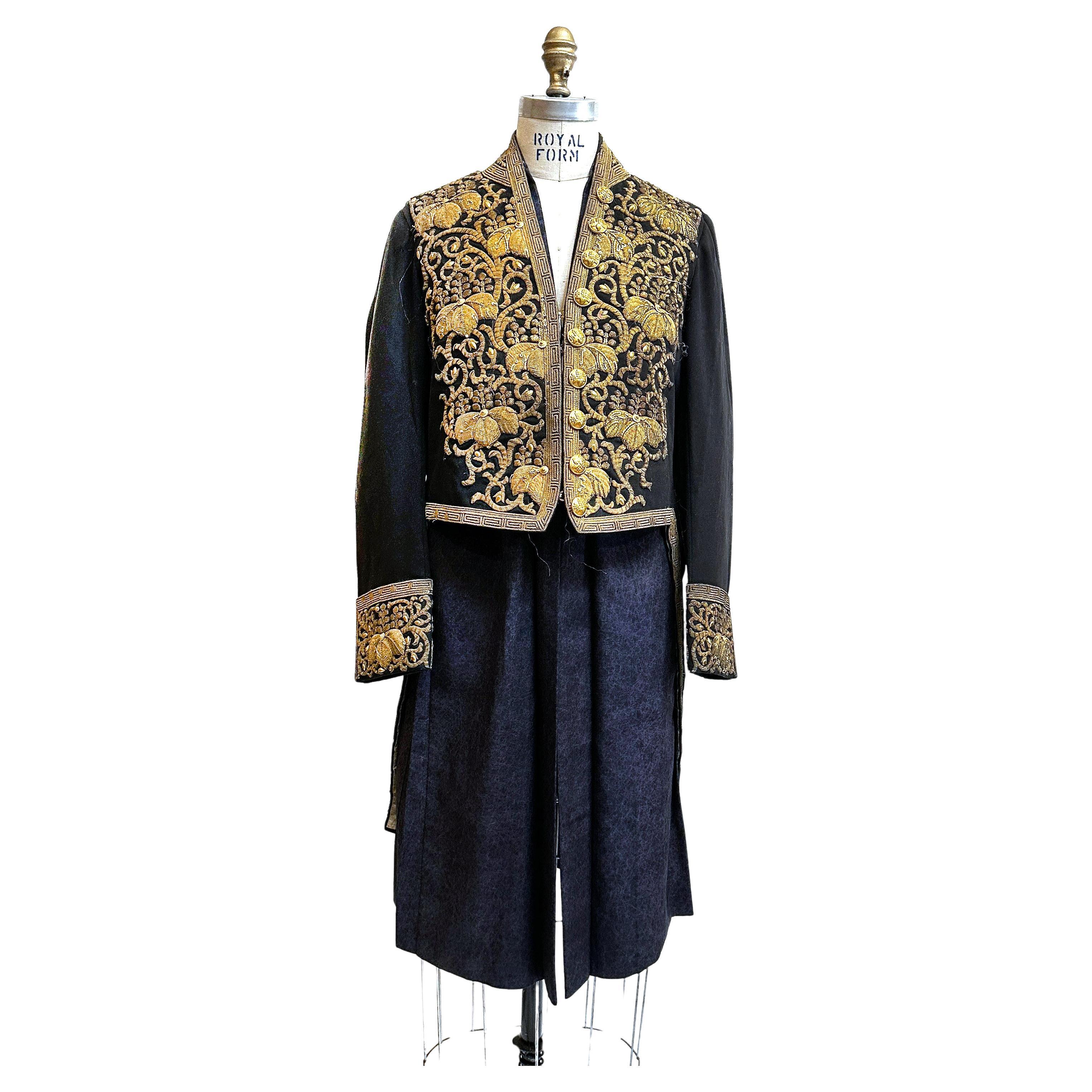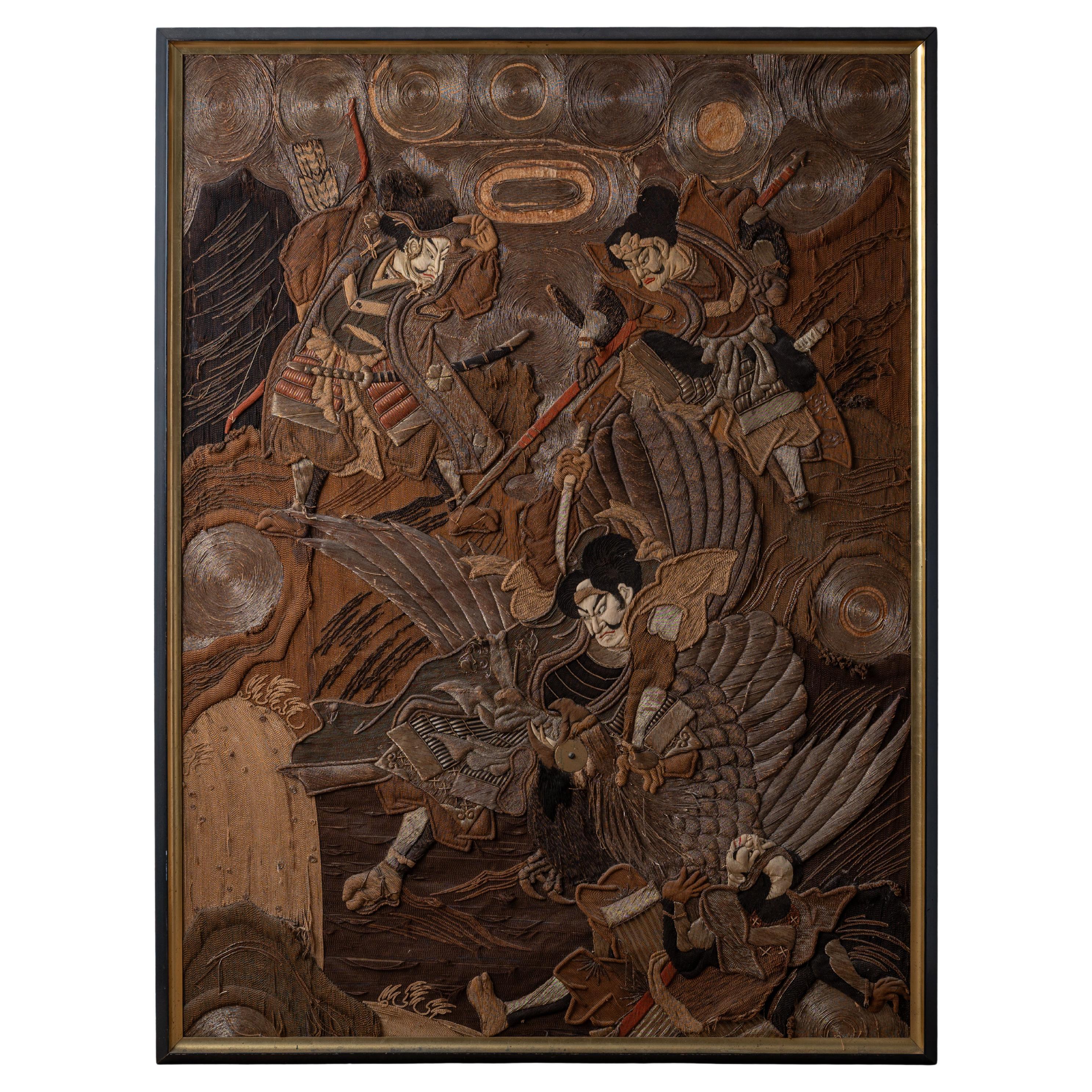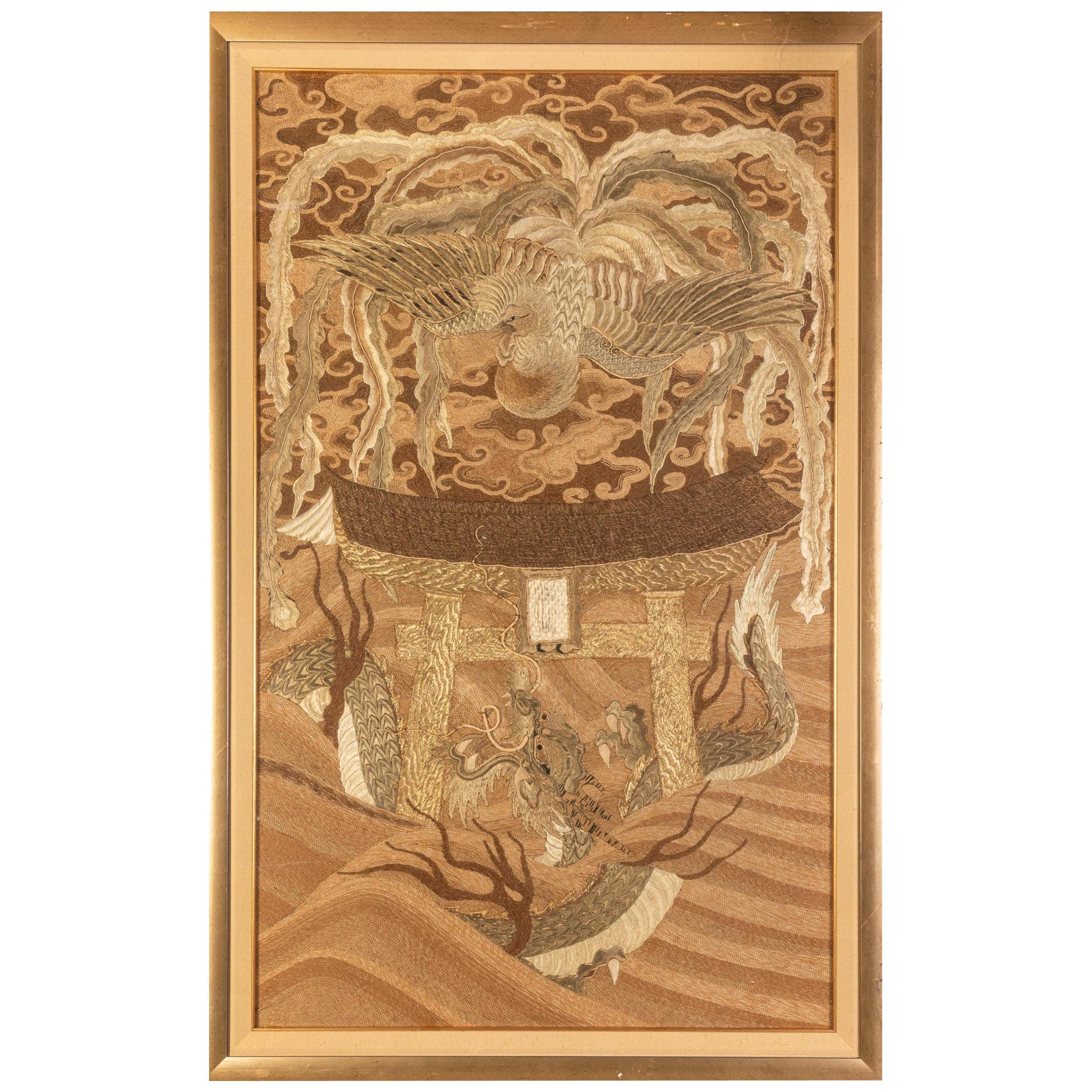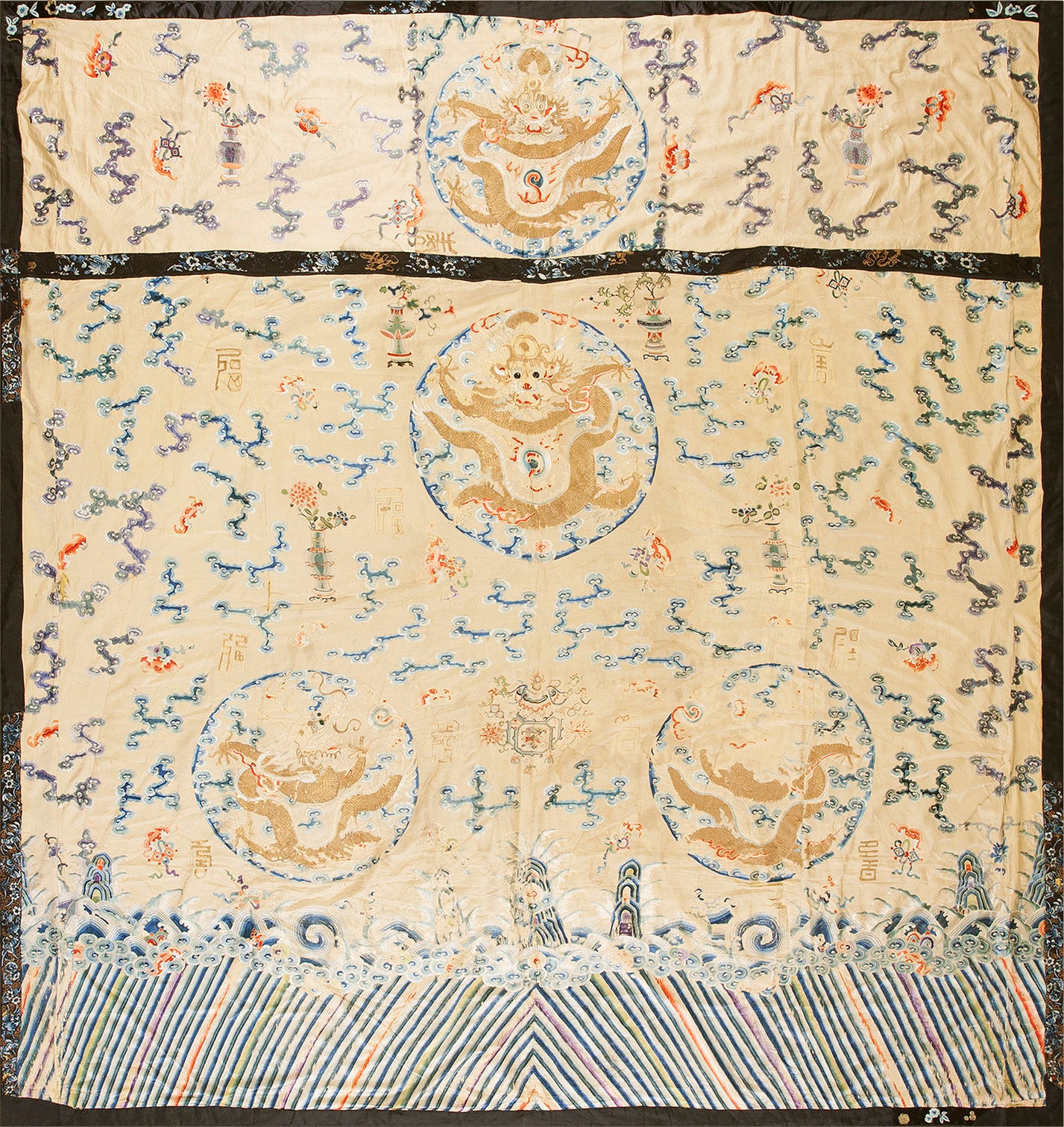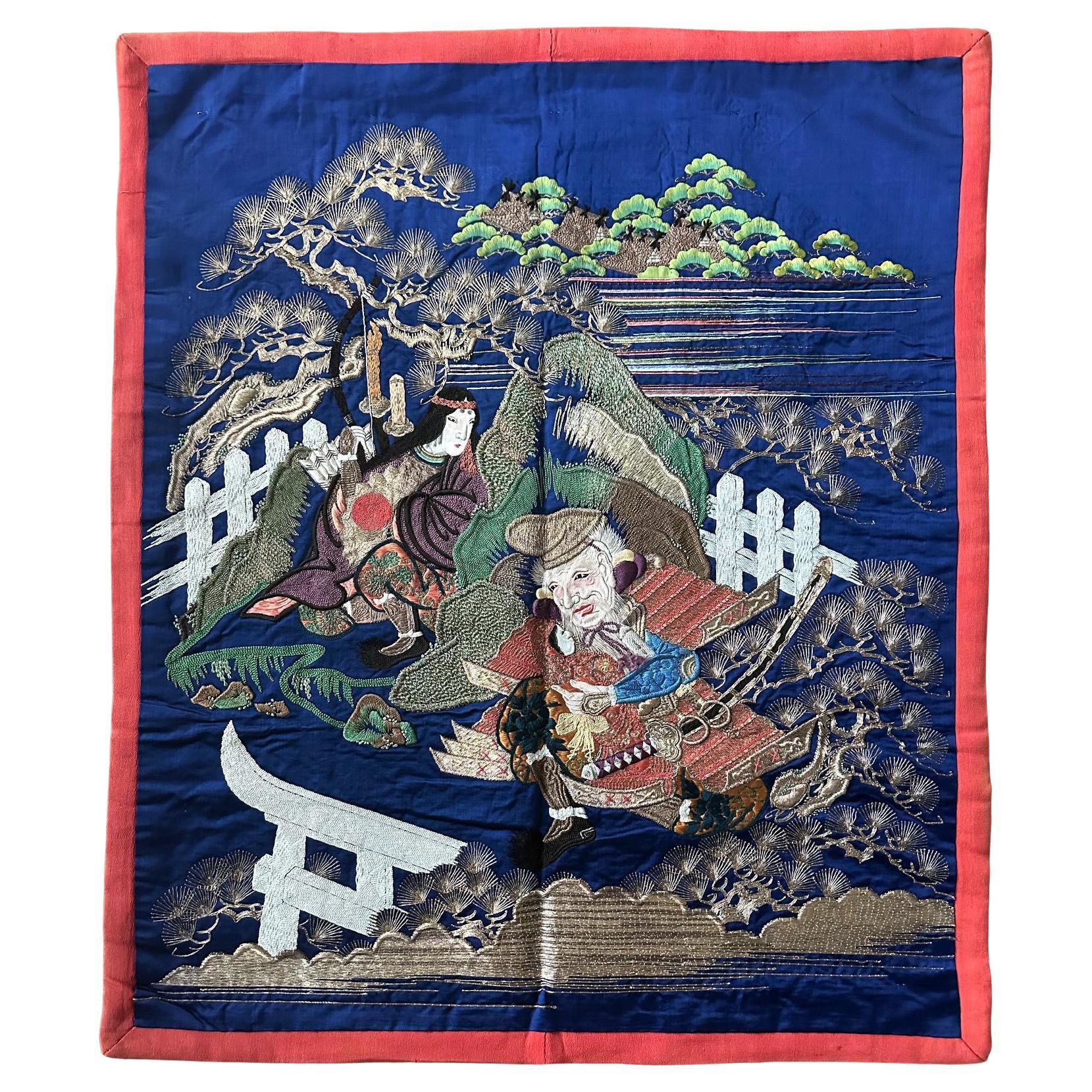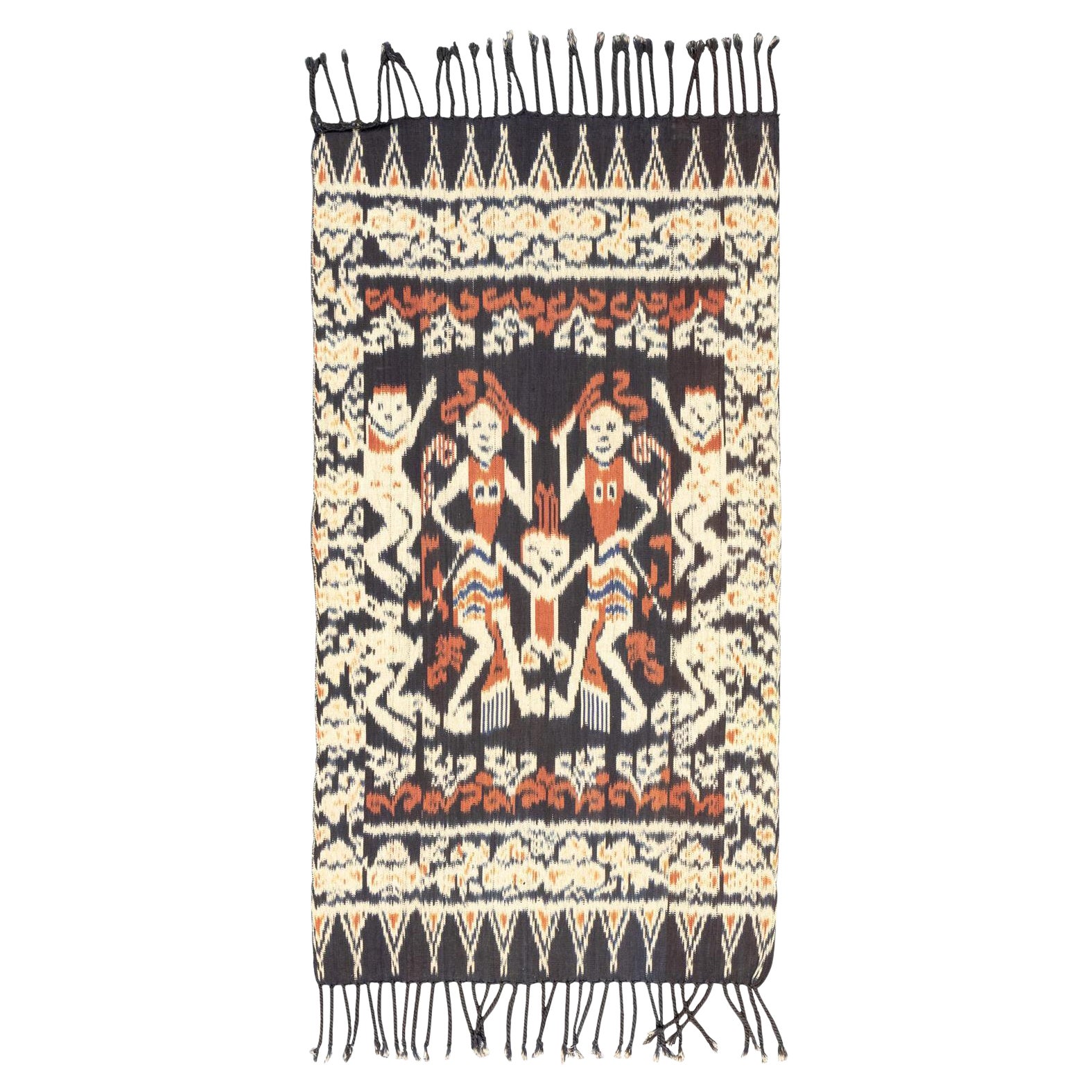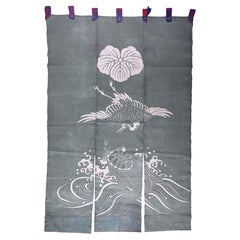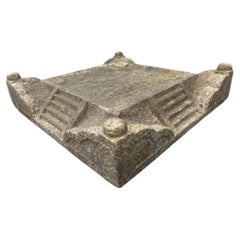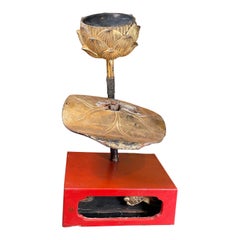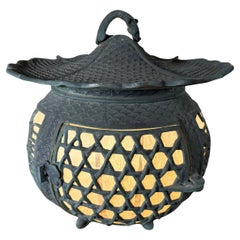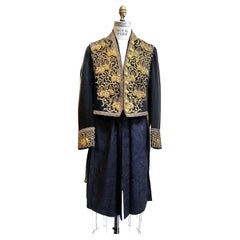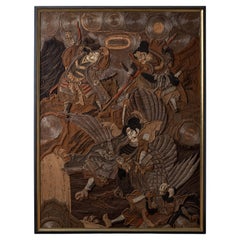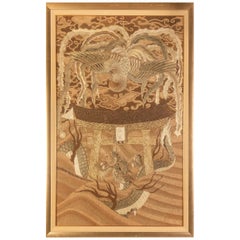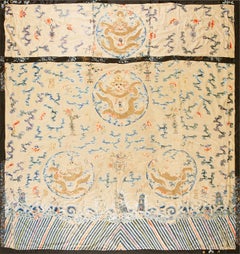Items Similar to Japanese 19th Century Kabuki Theater Gold Dance Costume Dragon And Phoenix
Video Loading
Want more images or videos?
Request additional images or videos from the seller
1 of 17
Japanese 19th Century Kabuki Theater Gold Dance Costume Dragon And Phoenix
$4,000
£3,090.69
€3,573.13
CA$5,652.29
A$6,339.42
CHF 3,319.86
MX$77,030.11
NOK 42,156.60
SEK 39,967.43
DKK 26,671.57
About the Item
A large, glamorous and impressive Japanese Kabuki Theater Kimono Dance Costume with a handsome dragon and phoenix motif dating to the Meiji period, 19th century. Hand crafted of brown velvet, colored fabrics, shells, and prolific metallic gold woven thread this historic robe measures approximately 58 inches tall and 54 inches wide.
This unique and rare brocade gold threaded robe presents itself as an important brilliant colored textile artifact from a great Japanese dancing tradition. It would frame well. The interior condition of this historic textile as you would expect is not in perfect condition from authentic and appropriate use wear just the way we like to find them, and may need some conservation though certainly not necessary as in its present condition would be a wonderful framed work of fine art.
Provenance: private old American collection
About Kabuki Theater
Kabuki (歌舞伎; Japanese pronunciation: [ka.bɯ.kʲi is a classical form of Japanese theatre, mixing dramatic performance with traditional dance. Kabuki theatre is known for its heavily stylised performances, its glamorous, highly decorated costumes, and for the elaborate kumadori make-up worn by some of its performers.
Kabuki is thought to have originated in the early Edo period, when the art's founder, Izumo no Okuni, formed a female dance troupe that performed dances and light sketches in Kyoto. The art form later developed into its present all-male theatrical form after women were banned from performing in kabuki theatre in 1629. Kabuki developed throughout the late 17th century and reached its zenith in the mid-18th century.
In 2005, kabuki theatre was proclaimed by UNESCO as an intangible heritage possessing outstanding universal value. In 2008, it was inscribed in the UNESCO Representative List of the Intangible Cultural Heritage of Humanity. Thank you wikipedia.
- Dimensions:Height: 61 in (154.94 cm)Width: 54 in (137.16 cm)Depth: 1 in (2.54 cm)
- Style:Meiji (Of the Period)
- Materials and Techniques:
- Place of Origin:
- Period:
- Date of Manufacture:19th century
- Condition:Wear consistent with age and use. Minor losses.
- Seller Location:South Burlington, VT
- Reference Number:1stDibs: LU1289245553072
About the Seller
5.0
Platinum Seller
Premium sellers with a 4.7+ rating and 24-hour response times
Established in 1990
1stDibs seller since 2015
2,386 sales on 1stDibs
Typical response time: <1 hour
- ShippingRetrieving quote...Shipping from: Charlotte, VT
- Return Policy
Authenticity Guarantee
In the unlikely event there’s an issue with an item’s authenticity, contact us within 1 year for a full refund. DetailsMoney-Back Guarantee
If your item is not as described, is damaged in transit, or does not arrive, contact us within 7 days for a full refund. Details24-Hour Cancellation
You have a 24-hour grace period in which to reconsider your purchase, with no questions asked.Vetted Professional Sellers
Our world-class sellers must adhere to strict standards for service and quality, maintaining the integrity of our listings.Price-Match Guarantee
If you find that a seller listed the same item for a lower price elsewhere, we’ll match it.Trusted Global Delivery
Our best-in-class carrier network provides specialized shipping options worldwide, including custom delivery.More From This Seller
View AllJapanese Antique Blue Doorway Curtain Noren for Happiness And Longevity
Located in South Burlington, VT
Symbolizing Happiness And Longevity
Japan, a rare antique hemp noren (doorway curtain) with auspicious congratulatory crane and turtle figures symbolic for happiness and longevity....
Category
Vintage 1920s Japanese Showa Textiles
Materials
Textile, Hemp
Japan Rare Large Antique Hand Carved Stone Altar Display Base, 19th Century
Located in South Burlington, VT
From Japan comes this seldom found , one of a kind large granite stone display base featuring four sets of altar steps- an impressive and spiritually significant object for displayin...
Category
Antique 19th Century Japanese Meiji Sculptures and Carvings
Materials
Limestone
$1,440 Sale Price
48% Off
Japanese Fine Antique Gilt and Red Lacquer Lotus Bud Flower, Edo Period 19th C
Located in South Burlington, VT
From our recent Japanese acquisitions, a rare find
Antique Original Japanese temple "blossoming lotus" flower bud stem including its original red lacquer display base. This finely hand carved wood and lacquered gold flower stem was made for a Buddhist 19th century temple altar. Its flower blossoms and leaves symbolize the stages of the path toward enlightenment. The individual parts of each lotus is carved separately then joined in an arrangement and inserted in altar vessels.
Also called "Jyôka" , it is placed on or next to an altar in a Buddhist temple. Made with meticulous techniques. In Buddhism, the lotus is an important symbol of divine enlightenment because it blooms into beautiful flowers while growing in mud. Tsunehana means "a flower that continues to bloom forever" and "a flower that does not wither." For this reason, the flowers represented are in different stages of their life, unfolded lotus leaves, buds and full flowers, thus symbolizing the journey towards Buddhist enlightenment.
This lovely Japanese antique gilt Lotus flower is an early survivor, circa 1840, and a hard to find treasure that was originally placed on or around a temple altar.
This ensemble consists of a single stem, the top most flower, and the bottom leaf- all mounted in the original square red lacquer display base. A gold gilt 3.5 inch long tortoise "minogame" is affixed to the base as seen in the photo.
Its attractive original old patina coupled with much of the original gilding remaining present is just the way we like to find them.
Dimensions: With original red lacquer display stand Height, 17 inches height and 9 inches in width. The lotus flower stem alone measures 16 inches in height.
Provenance: acquired from a Kyoto Japanse monk and collector
History of the Japanese turtle "minogame"
One of the most famous is the mythological giant turtle...
Category
Antique 1840s Japanese Edo Sculptures and Carvings
Materials
Wood
Japan Fine Antique Bronze Table Lamp With Writhing Dragon
Located in South Burlington, VT
Japan, a Fine jumbo sized 13" antique heavy hand cast bronze round lantern with exquisite details from the early Taisho period- one of the finest we have handled in over ten years. ...
Category
Early 20th Century Japanese Taisho Lanterns
Materials
Bronze
Antique Large Hand-Carved Garden Stone, 19th Century
Located in South Burlington, VT
An ideal garden ornament, sturdy weather proof planter display base or a rock solid all weather stone base for a special sculpture.
From China, comes this large 20.5 inch rectangu...
Category
Antique 19th Century Chinese Qing Sculptures and Carvings
Materials
Limestone
$396 Sale Price
20% Off
Japan Fine Bronze Seated Amidha Nyorai Buddha, 19thc.
Located in South Burlington, VT
Japan, an elegant and fine seated Amidha Nyorai Buddha with fingers clasped in a pensive "Dhyani" Mudra pose, a superb work of art cast in bronze. It dates to the 19th century Meiji...
Category
Antique 19th Century Japanese Meiji Sculptures and Carvings
Materials
Bronze, Copper
You May Also Like
Japanese Court Uniform for Imperial Appointee, 19th Century
Located in Point Richmond, CA
Court Uniform for Imperial Appointee, c. 1887.
Wool with gold brocade.
Court and military uniforms in emulation of European ensembles were officially adopted by the Japanese gover...
Category
Antique 19th Century Japanese Meiji Textiles
Materials
Wool, Brocade
Japanese Samurai Battling Tengu Embroidered Tapestry, 19th Century
Located in Savannah, GA
A Meiji tapestry of silk, wool and gold thread depicting samurai battling tengu, 19th century.
56 ¼ inches wide by 74 ½ inches tall by 2 inches deep
Category
Antique 19th Century Japanese Meiji Textiles
Materials
Wool, Silk, Wood
Framed Japanese Antique Phoenix Dragon Embroidery Tapestry Meiji Period
Located in Atlanta, GA
A visually stunning Japanese embroidery tapestry circa 1890s-1900s late Meiji period, presented with a linen matt with gold trim in a gilt wood frame. The design showcases a flying p...
Category
Antique 1890s Japanese Japonisme Textiles
Materials
Silk, Giltwood
Early 19th Century Silk Chinese Dragon & Clouds Embroidery
Located in New York, NY
Early 19th Century Silk Chinese Dragon & Clouds Embroidery
9'10" x 10' - 300 x 305
Category
Antique 1820s Chinese Textiles
Materials
Silk
Fine Japanese Embroidery Silk Fukusa Kabuki Story Meiji Period
Located in Atlanta, GA
A Japanese silk embroidery Fukusa panel circa 1890-1910s toward the end of Meiji Period. The spectacular needlework on this piece is a tour-de-force showcasing a scene from Kabuki th...
Category
Antique 1890s Japanese Meiji Textiles
Materials
Silk
Antique Textile Dancing Women Design, Late 19th Century
Located in Ferrara, IT
This is an antique Indonesian textile woven during the end of the 19th century circa 1890-1900 and measures 100x 54CM in size. This unique ...
Category
Antique Late 19th Century Indonesian Other Textiles
Materials
Cotton, Linen
More Ways To Browse
Antique Fabrics And Textiles Fabric Textiles
Antique Theater
Used Furniture In Phoenix
Japanese Dragon
Asian Artifacts
Antique Japanese Dragon
18th Century Costume
Framed Robe
Woven Gold Thread
Japanese Velvet
Dragon Light
19th Century Theatre
Japanese Phoenix
17th Century American Furniture
Framed Japanese Textiles
Gold Kimono
Dragon And Phoenix
Japanese Shell Art
